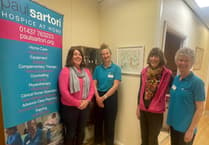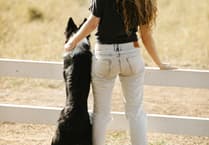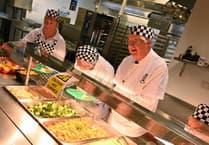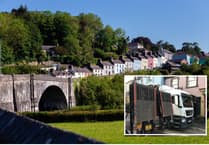More Prefab Memories
Last week's article about the prefabs brought some response - I am not alone in remembering with affection my early years spent as a prefab kid! Melanie Phillips, Pembroke's Mayor, was also brought up in the prefabs and told me that happy memories came flooding back to her when she read Keith Wheeler's account of growing up in the Orange Gardens prefabs at Jogram Avenue. So I asked her to share her memories.
"I too was brought up in the self same prefabs. I lived at number 10 and Squeak as he was known then (sorry Keith!) lived at the top end. I have memories of a very happy childhood surrounded by children of a similar age, as your photograph clearly shows. Most of the occupants of the prefabs were recently married young couples who had children the same age as my brother and I.
"There was a piece of derelict ground adjacent to our house and this became our playground. No health and safety regs applied in the '50s. The wasteland was covered in pieces of twisted metal and resembled a scrap yard. Paynter Street's private houses are now built on what we called 'Rough Ground.'
"'Rough ground' was also used to build our annual bonfire. The bonfire was well-constructed by the older boys and was completely dry and cosy inside. Old tyres were mainly purloined from Campbell's garage and cardboard and old newspapers from Simons or any kind shopkeeper who would supply us with some.
"The council lorry known as the Scavenger Cart would come around and remove your household waste and unwanted paper. We loved to see the cart when it was bornfire time. The driver was a man called Lennie Ball, and if you asked him nicely, he would supply you with some cardboard. The paraffin to light the fire was supplied by Chris Leonard.
"The older boys would sleep inside the wigwam bonfire all night in case the Monkton Terriers or the East End Water Rats raided our precious tyres and made off with the booty in the dead of night.
"We played very rough games. We roared around the block on gadges (Pembroke Dock kids called them trollies) and roller skates. My Uncle Ken worked for the Davies Steel factory in Pembroke Dock. They made roller skates. Ken gave my brother and I two pairs of steel roller skates. They were lethal because there was no rubber grips on the bottom of them. My brother used to hurtle around the pavements with sparks shooting out from behind him!
"On the right handside of the prefabs were private houses. These elderly people had lived in peace and harmony until we arrived. One old man in particular, when fed up with the noise of our skates and gadges, used to wait for us to zoom around the corner of his house and then throw out a coconut mat for us to trip over and stop us in our tracks. We would fall headlong over the mat; skin our knees on the pavement and on the rough fibres of the matting.
"Keith mentions The Bank. The bank is still there and descends straight onto the road beneath. It was on this bank that I learned to ride a bike. My neighbour had a 'sit up and beg' bike and she volunteered to teach me.
"I'll hold the saddle," she said. She didn't, and I found myself racing towards the Commons road. I found the brakes very quickly! What an initiation ceremony.
"It was on this same bank that Keith Wheeler told me nonchalantly that there was no Father Christmas.
"It's your mam and dad dressed up," he said gleefully. I ran home and told my Mam what he had said. "He's right said my mother. He's saved me the bother of telling you!"
"There was a horse on the Bank called Prince and it belonged to Laura Lewis, a relation of Wyn Jenkins and his sister Pauline. The horse was untethered and could usually be found on Pembroke Park!
"One thing puzzles me. The photograph shows all the kids who lived in the prefabs in the '50s except my brother Neil and myself. Perhaps we were whizzing around on those lethal skates or playing on 'Rough Ground'."
Bill Thomas's memories
Another person who has memories of these prefabs is Bill Thomas who was also able to supply a photograph.
"In the photo," he told me, "I am standing outside the prefabs in Jogram Avenue around 1950-52. My sister Peggy Thomas married Teddy Howell who was a postman and they moved there in 1947 after their wedding. I had just left school and I remember sanding down and staining the floors for a square of oil cloth which was all they could afford at the time."
He added: "It was very convenient - I used to take a bath there after playing rugby as we didn't have such a luxury in our house in India Row!
"The prefabs were only intended as a temporary solution to the post war housing shortage with a life of 10 years. The Jogram Avenue prefabs lasted 30 years, but there are still some standing - or were - as the 187 prefabs that make up the Excalibur Estate in Catford, South London (the last surviving post-war prefab estate left in Europe) have been in a long standing fight with Lewisham Borough Council which wanted to demolish and replace them with 371 modern homes. It seems, looking on the internet that they lost the battle in 2011 despite pleas to English Heritage to have them listed, only going as far as listing six on the estate to document the historic importance of this type of prefab. Whether this has now happened is not clear, but you can still see one in St. Fagans. It is not the same construction as the Pembroke ones (which were made with corrugated asbestos), but the layout is the same. I must say I would prefer any day to living in a prefab with loads of space for living and playing (happy days) than in the high density housing that is now the order of the day."
Thanks to everyone who contributes to this page by sharing their memories and photographs. It is so important to capture them - that is what our History Society is all about.
Contact
If you have any stories, photographs or feedback for this column, please contact me, Linda Asman, on 01646 622428, email [email protected]">[email protected] and visit our website http://www.pembrokeandmonkonhistory.org.uk">www.pembrokeandmonkonhistory.org.uk
Next event
Saturday, April 6 - Local History coffee morning and talk by Owen Vaughan, 'Stories behind the headstones at Monkton Priory Church', Monkton Church Hall, 10.30 - 12.30. Weather permitting, we will be taking a walk around the church.




